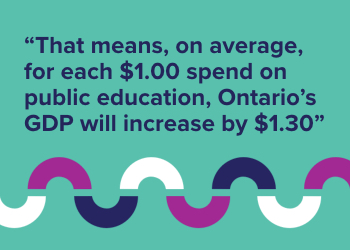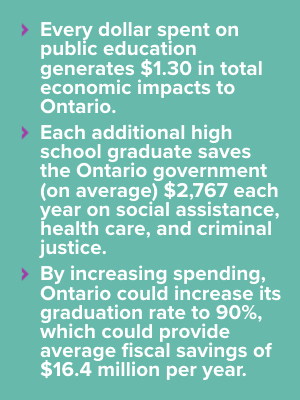Public education – a high return on investment
It has long been understood that education has many benefits for individuals, including higher earnings, better health, a longer life, and increased social capital. But what about the benefits to society? Is there a way to measure the overall impact of investing in education?
Conference Board of Canada economist, Aimee McArthur-Gupta decided to find out.

Public education fuels the economy
 The researchers for The Economic Case for Investing in Education report used a number of perspectives to examine the overall benefit of public education.
The researchers for The Economic Case for Investing in Education report used a number of perspectives to examine the overall benefit of public education.
First, there is the simple fact that K to 12 education supplied 290,000 jobs to Ontarians in 2018, representing 4.5% of all the jobs in the province. Each employee, in turn, buys goods and services, purchases or rents homes, pays taxes, and spends money of a range of services – thus fueling economic growth.
The benefit to the economy is quantifiable: The Conference Board estimates that every dollar in increased spending on K-12 education produces an impact of $1.30. For example, if the province increased education funding by 1%, or $291 million, it would result in an economic impact of $371 million.
Spending on public education has social benefits
 To measure the cumulative impact of educational attainment on health spending, the researchers, compared the costs of public health care for high school graduates versus high school drop outs. They found that, on average, a high school dropout in Ontario uses approximately $800 more in health spending than a high school graduate. Taking that calculation, they estimated there would be annual savings of $6.4 million if graduation rates in Ontario increased to 90% from their current 86.3%.
To measure the cumulative impact of educational attainment on health spending, the researchers, compared the costs of public health care for high school graduates versus high school drop outs. They found that, on average, a high school dropout in Ontario uses approximately $800 more in health spending than a high school graduate. Taking that calculation, they estimated there would be annual savings of $6.4 million if graduation rates in Ontario increased to 90% from their current 86.3%.
By the same token, high school dropouts are more than twice as likely as high school graduates to use provincial social assistance. An increase in graduation rates to 90% would save approximately $5.1 million per year.
There is also a relationship between educational attainment and the chances a person will be involved in the criminal justice system. Using the same method, the report estimates that the improvement to graduation rates would produce annual savings of $4.9 million in criminal justice spending.
Overall, the report estimates that investing in improved graduation rates in Ontario, would lead to savings of $16.4 million per year. While that may seem like a relatively small amount in the short term, over a period of two decades, it would amount to $3.5 billion in savings.
“…our findings suggest that improvements to public education could be a means of alleviating costs in other public expenditures, such as social assistance, health care, and criminal justice services.”
